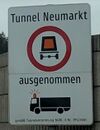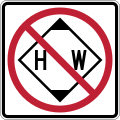FR:Key:hazmat
| Description |
|---|
| Restrictions de circulation des véhicules transportants des matières dangereuses. |
| Groupe: restrictions |
| Utilisé pour ces éléments |
| Combinaisons utiles |
|
| Voir aussi |
| Statut : Approuvé |
| Outils pour cet attribut |
|
Si vous comprenez l’original en anglais, merci d’apporter votre aide pour compléter cette traduction française. Lisez les instructions concernant la traduction de ce wiki.
agaric travaille actuellement sur cette traduction.
Permet de préciser si le transport de matière dangereuses est autorisé ou contraint sur cette route si un tel panneau est présent.
Usage
Les routes où le transport de matière dangereuse est interdit peut-être taggé avec hazmat=no.
Pour les véhicules transportants ces matières dangereuses, une voie obligatoire est souvent précisé en aval sur un fond bleu.
Quand la réglementation locale subdivise les matières dangereuses en plusieurs groupes, il peut-être ajouté une colonne, par exemple
hazmat:A=no.
De telles divisions peuvent être décrites sur cette page (une par pays si des variations existes).
Valeurs habituelles
- designated
- no
- destination
- Liste des valeurs permisses avec la clé Key:access
Restrictions liées aux Tunnels
Restrictions générales au sein de l'Union Européenne
Une régulation spécifique s'applique aux tunnels (et route), elle est bassée sur un traité onusien signés par plus de 50 pays (pas tous de l'Union Européenne). Ce traité ADR définit 5 catégories (A, B, C, D, E).
| Catégories de Tunnels | La catégorie sélectionnée fixe la liste des marchandises dangereuses dont le transport est interdit dans le tunnel | Transport de marchandises dangereuses autorisé dans le tunnel | Exemple |
| A | transport de marchandises dangereuses sans restrictions | B, C, D, E et marchandises dangereuses sans code de restriction de tunnel | Austria, B171, Kufstein-Pians, Stadtberg, code A, Note: required use of warning lamps in accordance with ECE regulation 65 |
| B | restriction du transport de marchandises dangereuses avec une très grande portée d’explosion | C, D, E et marchandises dangereuses sans code de restriction de tunnel | Germany, A31, Leer, Ems, code B. |
| C | restriction du transport de marchandises dangereuses avec une explosion d’empoisonnement à très longue portée, à longue portée ou à longue portée. (gaz ou liquide volatil) | D, E et les marchandises dangereuses sans code de restriction de tunnel | France, A43, Modane-Bardonnechia(it), Frejus, code C, Note: Required escort for ADR classes 1 and 2. |
| D | la restriction du transport de marchandises dangereuses qui menacent une explosion à très longue portée, une explosion à longue portée ou un empoisonnement à grande échelle ou un incendie de grande ampleur | E et les marchandises dangereuses sans code de restriction de tunnel | Netherlands, A22, Velsen, Velsen, code D |
| E | La restriction s’applique à toutes les marchandises dangereuses, sauf : ONU 2919, 3291, 3331, 3359, 3373 | marchandises dangereuses sans code de restriction de tunnel, sauf: UN 2919,3291, 3331, 3359, 3373 | Germany, Hamburg, Kronstieg, code E, Note: 06:00-21:00. |
- https://www.tes.bam.de/en/regelwerke/tunnelvorschriften/index.htm
- EU minimum safety requirements for tunnels https://ec.europa.eu/transport/road_safety/topics/infrastructure/tunnels_en
Restrictions spécifiques
| Example | Tag | Meaning |
|---|---|---|
 |
hazmat=no |
les véhicules contenant des matières dangereuses ne sont autorisés à entrer que s’ils utilisent un feu clignotant |
Spécificités des pays
Finlande
Use hazmat=no, but hazmat:B=destination - the auxiliary sign "VAK(B)" allows the transport to destination on that road, despite the name of the main traffic sign. Some places have a hazmat=designated to divert such traffic onto motorways.
Groups A and B exist. Their difference is (mostly) only in the amounts allowed, as defined separately for some 10 material classifications. Group B allows more of the materials. That is, for example less than 50 kg of explosives onboard is not a hazardous transport (by the signs, that is), any transport of 50 kg or more must obey they signs for group A (hazmat:A=*) and a transport of over 500 kg belongs to group B (hazmat:B=*).
France
L'usage le plus fréquent est hazmat=no.
Le gouvernement français publie une liste non exhaustive des tunnels restreignants le transport des matières dangereuses: Tunnels de + de 300 m - régime TMD - liste non exhaustive (Centre Étude des TUnel alias CETU) La majorité d'entre-eux sont soit du groupe A soit du groupe E.
Allemagne
In Germany exists a positive and negative network for transporting hazardous materials. Other streets should only be used to reach your destination. In water protection areas you can find special signs to protect water against contamination. For this we create a special subclass hazmat:water=*.
| hazmat=designated | Driving with hazardous materials explicitly encouraged (DE:Grundnetz Gefahrguttransporte) | |
| hazmat:water=permissive | Drivers of water contaminating materials should use a other route. | |
| hazmat:water=no | Driving with water contaminating materials forbidden. | |
| hazmat=no | Driving with hazardous materials forbidden. |
Additionally Germany uses the European tunnel categories A - E. Traffic sign DE:261 ![]() relate to hazardous materials, most times with attachment sign DE:1014-50, DE:1014-51, DE:1014-52 or DE:1014-53 to specify tunnel category. To specify access restrictions to ways these traffic signs should be translated to OSM-tags as followings:
relate to hazardous materials, most times with attachment sign DE:1014-50, DE:1014-51, DE:1014-52 or DE:1014-53 to specify tunnel category. To specify access restrictions to ways these traffic signs should be translated to OSM-tags as followings:
| Sign | Tags | Meaning | Description type of goods |
|---|---|---|---|
hazmat=no |
No access for vehicles carrying hazardous substances. | No passage for any dangerous goods. | |
| hazmat:B=no | No access for vehicles carrying hazardous substances which are not allowed to pass tunnels of category B. |
No transit with dangerous goods that can lead to a very large explosion. | |
| hazmat:C=no | No access for vehicles carrying hazardous substances which are not allowed to pass tunnels of category C. |
Same restriction as for category B plus dangerous goods that can lead to a large explosion or extensive release of toxic substances. | |
| hazmat:D=no | No access for vehicles carrying hazardous substances which are not allowed to pass tunnels of category D. |
Same restriction as for category C but also corresponds to dangerous goods that can lead to large fire. | |
| hazmat:E=no | No access for vehicles carrying hazardous substances which are not allowed to pass tunnels of category E. |
No passage for any dangerous goods, with the exception of UN2919, UN3291 and UN3373 (certain radioactive materials, clinical waste and materials) |
Note:
For more details on type and amount of hazardous substances which are allowed to pass tunnel of a certain category see Zweck des Tunnelbeschränkungscodes (TBC) (german).
Tunnel category A is specified but not required to be shown as traffic sign for road users as there are no restrictions for hazardous materials on this category. However, on tunnel entry portal you may find a plate like DE:1014-50 but showing letter A. This is for information only that this tunnel had been specified according to tunnel category A.
Guatémala
Pays-Bas
The Netherlands uses the European tunnel categories A - E. Traffic signs C22 ![]() and K14
and K14 ![]() relate to hazardous materials. These are translated to OSM-tags in the following way:
relate to hazardous materials. These are translated to OSM-tags in the following way:
États-Unis d'Amérique
- Article principal : w:Dangerous goods#United States
California:
hazmat=designatedCalifornia:
hazmat:waste=designated?California:
hazmat:waste=no?
Hazardous cargo restrictions have generally been tagged using hazmat=no. As of November 2020, very few class-specific hazardous cargo access restrictions have been tagged in the United States, so far mostly in California. Following the general guidance above, one would use keys under the hazmat:* namespace to indicate specific restricted classes:

hazmat:1=no
hazmat:2.3=no
hazmat:4.3=no
hazmat:6.1=no
hazmat:7=no
hazmat:2.1:conditional=no @ bulk
hazmat:3:conditional=no @ bulk
hazmat:4:conditional=no @ bulk
hazmat:5:conditional=no @ bulk
hazmat:6:conditional=no @ bulk
hazmat:8:conditional=no @ bulk
On the highway=motorway_link way for the exit:
hazmat=designated
To determine the correct class for each placard, consult the following guides from the U.S. Department of Transportation:
- Nine Classes of Hazardous Materials (Yellow Visor Card)
- Hazardous Materials Markings, Labeling and Placarding Guide (DOT Chart 15)
- How to Comply with Federal Hazardous Materials Regulations
California signposts hazardous cargo restrictions using state-specific signs that do not explicitly include the placards:
Local transportation authorities may have their own detailed guides as well, such as this guide from the Port Authority of New York and New Jersey.
Voir aussi
- Restrictions conditionnelles, correspondant à motor_vehicle:conditional=* @ (hazmat); qui est favorisé par Proposed features/Conditional restrictions over hazmat=* (et probablement encore plus pour hazmat:conditional=*).
- List of tunnel limitations in the transport of hazardous materials
- Le site web du Centre d’Études des Tunnels du Ministère (CETU) chargés des Transports publie une litse non exhaustive des Tunnels de + de 300 m - régime TMD
- boundary=water_protection_area (de)
- access=*







